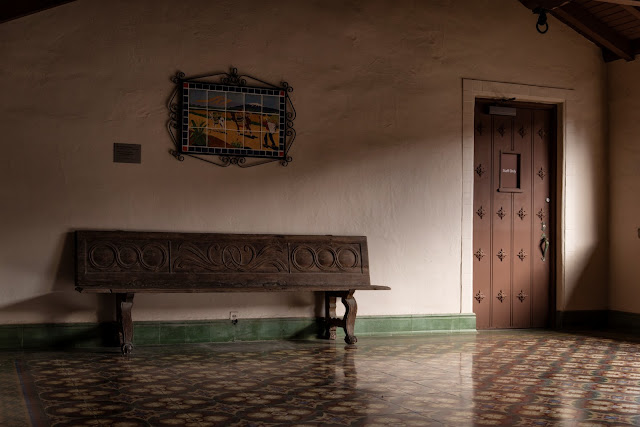Flowers at a fountain in the old courtyard of the McNay Museum.
I spent a lot of time in San Antonio over the last year and a half taking care of my father, who passed away at the end of May. I had not been back to San Antonio since then but I woke up yesterday with the idea that I needed to revisit the city to keep from having those recent days of responsibility and sadness harden into my lasting impression of the city in which I grew up. There is so much I like about San Antonio and its vibrant downtown is part of that. I needed to feel welcome again.
So I decided to give downtown Austin a day off from my Paparazzi abuse and, after early morning swim practice, I grabbed the camera that keeps resurfacing as an odd but highly attractive choice, and headed out the door. I stopped by the Goodwill store to donate an old scanner, then hit Starbucks and was on the road by 10 a.m. Traffic was light heading down IH-35 to the River City. I pulled up to a parking meter just a few blocks from the Alamo and laughed for a few seconds when I saw the parking rates. San Antonio still charges 30 cents an hour in the very center of their downtown!!! About a quarter of the usual parking fee charged at meters in Austin....
I was dressed for comfort and a bit of protection from the sun and, to lighten my load, I only carried one camera and one lens. My choice for the day was a Pentax K-1 and the small, elegant and dense-packed 28-105mm lens. In my mind it was the perfect choice for an afternoon of random rambling. Beautiful files, lots and lots of resolution, and enough dynamic range to keep even the wizards of DXO moderately happy. Yes, the camera is chunky and a bit heavy but it's bits of friction that keep us paying attention to our process.
As is my habit, I kept an extra, charged battery in my pants pocket, along with a wad of cash and my wallet. No camera bag. No sling thing. No backpack. Nothing to make the process physically arduous.
The Pentax K-1 has a sharper, brighter look than the Fujis I normally use and it just begged to be unleashed on some architecture. I'm not an architectural photographer but I love photographing urban "landscapes" when I'm walking with no purpose other than to walk and look. I did find myself waiting in front of old buildings, like the ones below, waiting for people to either enter the scene or to move on, or for clouds to blow over, so I could harness the hard edge of bright sunlight. I also found myself (uncharacteristically) stopping just to look at a building facade for a while as though by doing so I might unlock some secret to making a better image.
Of course, I was just shooting for myself so I wasn't feeling compelled to shoot in a certain way or to come home with images that look like all the other "perfect" images of buildings, which I tend to see a lot. I felt as though I was doing "snapshots" of old friends because these are buildings (for the most part) that existed long before I started heading into downtown S.A. in the 1970's with a little film camera in my hand. I've seen the fronts in disrepair, seen them renovated and smelled the fresh paint, and then seen them decline again. It's like a special season that follows the economic conditions of the city.
I like the look of strong, stark blue skies dotted with puffy clouds. I like hard edges on most architecture. I try to look for compositions and color pairings that are bold and contrasting. I'm rarely trying for subtlety, and even more rarely trying to make a "classic" image of a structure in which all the blinds are drawn to the same measure in each window and all the edges of the building are parallel and straight up and down. I'm more in the mode of trying to coax out the character of the old storefront or apartment house.
I walked around in the heat on my usual route. I start near the Alamo and then walk across downtown via Commerce St. (passing by the St. Fernando Cathedral) until I get to the Mercado; mecca for all tourists to The Alamo City. After mingling with the other tourists and becoming overwhelmed with all the insane and tacky souvenirs, I resist getting a temporary tattoo, or having my face painted, and I head back in the direction from which I came but I do so on Houston St., just for the visual variety. I laughed to myself when I thought about this route I've constructed because the family of my beautiful girlfriend in high school owned a clothing store on Commerce St. while the family of my best guy friend owned a tonier men's wear store on Houston St. Both stores have long been sold off by the respective families and it's always interesting to me to see what kinds of businesses are in the spaces now...
I'd been walking since 11:30 and by 2:00 p.m. it was really hot and the air was sticky and moist, like steam from a kettle, whistling on a burner. It was time to find some air conditioning, a cool drink and a calm lunch. I didn't want to go to a regular restaurant with table service, wasn't in the mood for Tex-Mex, and not of a mind to try something exotic and new either. I looked around as I walked and was happy to find a shop called, The Royal Blue Grocery. It's a small, small chain of stores that started in Austin as little deli/grocers for people who lived in the big, high rise condominiums that dot our downtown. They serve great, hot sandwiches, make killer coffee and have a better selection of wines that one might imagine. The one on Houston St. in San Antonio is new and is their first one in that city, and maybe the first one outside of the magnetic pull of Austin.
I parked my camera on a table, grabbed a (glass) bottled water and order a Cuban sandwich. Pulled pork, some ham, delicious pickles and onions, some melted provolone cheese, and just the right amount of a picante sauce. It was exactly what I wanted in the moment. Absolute comfort food and nothing budget straining.
I shot and walked for another hour before heading to the McNay Museum which is one of my favorite art museums in the world. By the time the museum closed I'd shot a couple hundred images, had a great lunch, made a modicum of peace with the city and its ghosts, and felt like I'd accomplished something I have a hard time putting into words; not actually relaxation but maybe re-integration.
I knew the images I'd shot on the K-1 looked nice on the back screen of the camera but I've been fooled by LCDs so many times before. Because of that I was especially happy to sit in front of my computer today and find so many that I liked so much; most of which were good right out the camera and great with just the tiniest bit of Adobe-coaxing. Always just a little brighter. Always just a bit more shadow detail.
I have more stuff to show but it's far more quirky than these buildings. I thought that instead of mixing them in one post I'd get two days of posting joy from one afternoon's adventure. So, if you "hate the buildings" stay tuned and I'll get some non-building stuff up in your face tomorrow.
So, how was the Pentax? Vexing! I never expected that camera and that lens to be so good or so comfortable to use. Now I'll never be able to make up my mind about which camera to take with me to Montreal next weekend. A very nice problem to have. Thank you very much.
Commerce St.
Commerce St.
Commerce St.
Commerce St.
Commerce St.
Commerce St.
Commerce St.
Commerce St.
The Signage for the historic Aztec Theater.
The Robert E. Lee Hotel as seen from Houston St.
Don't know if you can read it all but the sign underneath the name says,
"Air Conditioned."
Houston St.
Houston St.
Houston St. The old Bromley Communications Bldg.
One of SA's big advertising agencies. Now headquartered in
some other part of the city.
A Pillar at the McNay Museum.
The McNay Museum.
Entrance to the sculpture gardens at the McNay.
And no trip to S.A. is complete without at least a view or two of the Alamo.
A beefy camera and a moderate zoom lens. What more could you need?
Well, at least for walking around a city...


















































